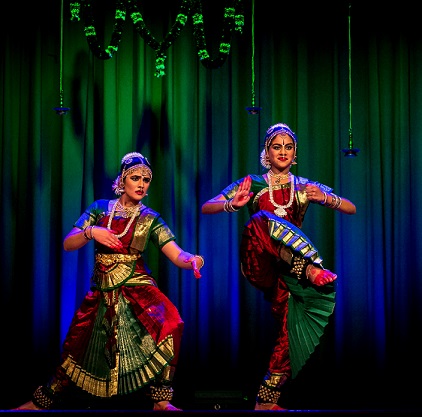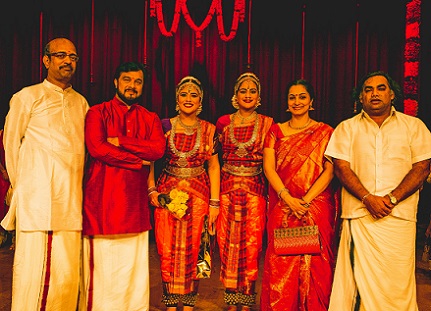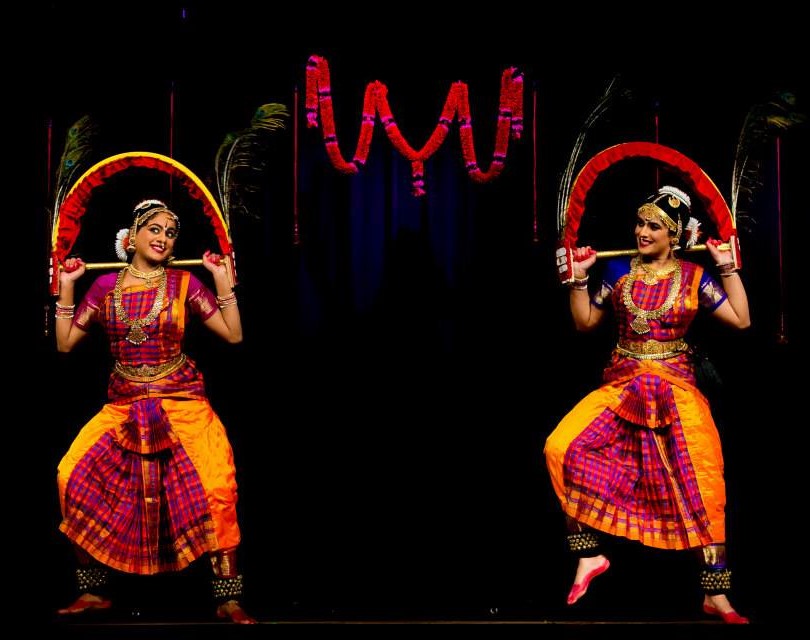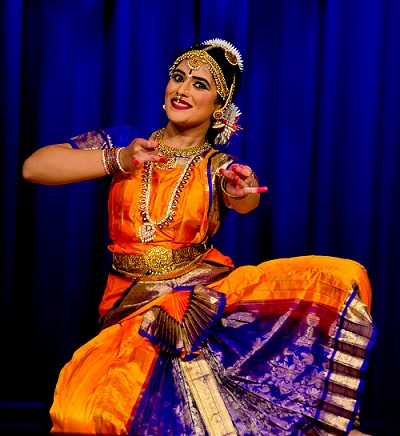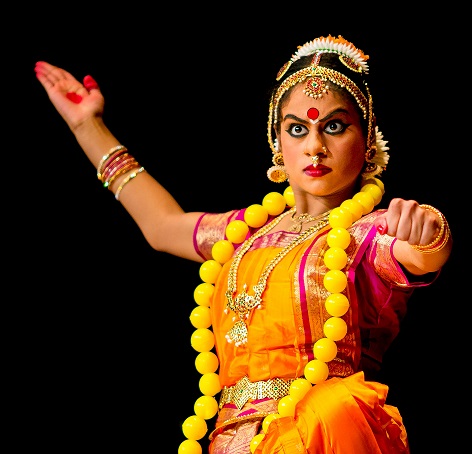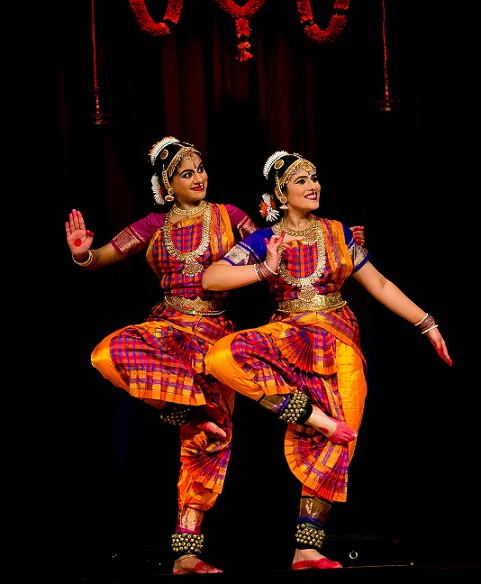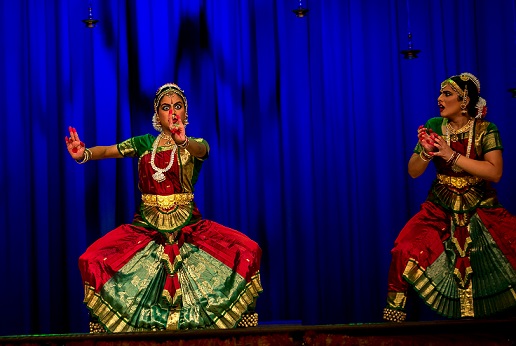Contribute
| Arangetram: Sanjana Rao And Rinija Raja Take The Stage By Storm |
Kedar Risbud and Shreyas Risbud
09/22/2015
The Bharatanatyam Arangetram is not a new feat to Bostonians. However, only the notable ones become etched in their memory as Boston’s Indian audience is known to be an informed critic of Indian classical music and dance and is always hungry for fresh, new ideas in these art forms. The Arangetram performance on Saturday, September 12, 2015 of Sanjana Rao and Rinija Raja who are disciples of Smt. Sapna Krishnan, was just that; energetic, rich in the variety of the dance items presented, and with some pleasant departures from the traditional format of an Arangetram, thus an absolute pleasure to watch.
A brief prayer sung by Sri. Sudev Warrier, supported by Sri. K. S. Sudhaman (Mridangam), Sri. Ramani Thiagarajan (Flute and Khanjira), and Smt. Sapna Krishnan (Nattuvangam), set the mood of this auspicious event for Sanjana and Rinija. The musical ensemble received a thunderous applause for this prayer as, by this time, the audience had got a glimpse of a melodious journey that they were about to embark on.
Sapna and Rinija began with a Pushpanjali in Raga Amritavarshini. In this invocation to Ganesha, this duo of dancers displayed a tremendous amount coordination, as the choreography had a number of intricate formations relying on symmetry and balance. Alarippu, a preparatory dance in Thrisham (3 beats) of this Bharatanatyam Arangetram, was the next item presented by this duo. While allowing each dancer to individually display their expertise in Nritta, their Guru Sapna Krishnan had intelligently choreographed some adavus using the technique of double-act. Although abundantly used in staged comedy acts, this technique is seldom used in Indian classical dance. Such was their togetherness that Sanjana and Rinija would momentarily fuse into one dancer.
Moving away from the Arangetram tradition of presenting a Varnam in which Nritta, Nritya, and Abhinaya come together, thus making it the most demanding item of the repertoire, Sanjana and Rinija presented Dashavataram. This item portrayed ten incarnations of Vishnu, one of the trinities in Hindu belief. It was set to ‘Pralaya payodhi jale…’ from Geet Govind, a compilation of Sanskrit poems written by the 12th century poet Jayadev. Like a Varnam, this item was equally demanding on both of the dancers when they enacted these ten incarnations with stories that embedded the navarasas and each with its complicated Jati. This was one of the best Dashavataram choreographies and performances I have seen. The audience was so emotional and overwhelmed that Sanjana and Rinija drew a well-deserved spontaneous standing ovation from the audience for this item.
Rinija and Sanjana also presented a few solo items. Rinija’s ‘Shanmukha Kautuvam’ in Raga Shanmukhapriya and Sanjana’s Kannada Devaranama ‘Adidano Ranga…’ in Raga Hansanandi were unique choreographies, as the dancers were in dialogue not only with the Nattuvangam, but also with the Mridangist who interjected vocal recitation of some empowering Jatis. Sanjana brought Mount Kailash to the stage with her vibrant dance in Shiva Tandava in Raga Purvi Kalyani, while Rinija brought out the vigor of Mahishasur Mardini goddess Durga in the number ‘Mahakali, Mahashakti, Maheshwari…’ in Raga Bowli. The ‘Mahishasur Mardini’ chant recited by Nilanjana Nambiar in the background added another dimension to this rhythmic composition. Presenting a Telugu Keerthanam composed by Annammacharya in praise of Hanuman, Rinija depicted Hanuman’s devotion to Prabhu Shriram. Sanjana was equally expressive as Krishna, the prankster of Gokul, while performing a Tamil Padam ‘Thaye Yashode…,’ which described numerous tricks Krishna would play on the Gopis.
The Tamil folk tune Kavadichindu proved that these two dancers could also handle the folk style equally well as they did the pure classical dances. The last item presented by Sanjana and Rinija was a Thillana in Raga Chandrajyothi composed by none other than the vocalist of the day, Sri. Sudev Warrier.
Guru Sapna Krishnan’s arduous training was quite evident throughout the entire evening. Both the dancers were as energetic until this last item as they were when the recital began. Sudevji’s rich and deep voice spanning more than three octaves with ease made the lyrics of each song come to life. With his mellifluous flute Sri. Ramani Thiagarajan was able to produce sounds of conch, too, that a few numbers required. Thiagarajan sir also displayed his mastery on Khanjira during his Jugalbandi with Sri. K. S. Sudhaman’s Mridangam. With his vibrant fingers producing a plethora of sounds on Mridangam, including Shiva’s damaru, Sudhaman sir frequently involved the audience throughout the course of his phenomenal Mridangam exhibition. Smt. Padmini Balaji who was the Master of Ceremony, effectively narrated each item for the audience. The artists behind the scene; Ms. Niveda Baskaran, herself an extraordinary Bharatanatyam dancer, and Smt. Janaki Baskaran maintained the fresh look of the dancers with beautiful make-up.
Both the Rao and Raja families had planned this event with meticulous attention to detail. Sanjana and Rinija genuinely poured their heart and soul in each item. The audience was left mesmerized and could appreciate each number with a heartfelt applause because the artists themselves were enjoying what they were presenting. I congratulate Sanjana and Rinija for their grand achievement and wish them success in their journey towards higher levels in this art form.
You may also access this article through our web-site http://www.lokvani.com/
